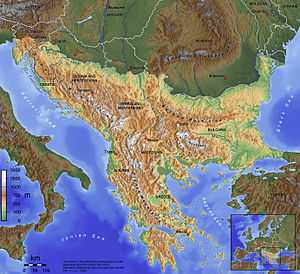Southeast Europe
| Southeast Europe | |
|---|---|
|
Geographic features |
Southeast Europe or Southeastern Europe is a geographical and political region located primarily in the Balkan peninsula. Sovereign states that are generally included in Southeastern Europe are, in alphabetical order, Albania, Bosnia and Herzegovina, Bulgaria, Croatia, Cyprus, Greece, Kosovo,[lower-alpha 1] Moldova, Macedonia, Montenegro, Romania, Serbia, Slovenia and Turkey. These boundaries can vary greatly due to the political, economic, historical, cultural, and geographic considerations of the observer.
Definition
The first known use of the term "Southeast Europe" was by Austrian researcher Johann Georg von Hahn (1811–1869) as a broader term than the traditional "Balkans".[1]
Balkans model

This concept is based on the boundaries of the Balkans peninsula.
The countries that are located fully in the peninsula are the following: Albania, Kosovo, Bosnia and Herzegovina, Bulgaria, Greece, Macedonia and Montenegro.[2]
The countries that are located partially in the peninsula are the following: Croatia, Italy, Romania, Serbia, Slovenia and Turkey.[3]
States in Southeast Europe
 Albania
Albania Bosnia and Herzegovina
Bosnia and Herzegovina Bulgaria
Bulgaria Croatia [4][5][6]
Croatia [4][5][6] Cyprus [7][8]
Cyprus [7][8] Greece
Greece Kosovo [lower-alpha 1]
Kosovo [lower-alpha 1] Macedonia
Macedonia Moldova
Moldova Montenegro
Montenegro Romania
Romania Serbia
Serbia Slovenia
Slovenia
- Regions within other states
- Southern Italy, where the population has prehistoric genetic ties to the Balkans,[9] was part of the ancient Greek world, and where linguistic minorities speak various Balkan languages.
- East Thrace, Turkey – the area immediately north of the Bosphorus, constituting approximately five per cent of Turkey's land area. East Thrace comprises Edirne Province, Kırklareli Province, Tekirdağ Province, and part of Istanbul Province.
Stability Pact for South Eastern Europe model

The Stability Pact for South Eastern Europe was an institution aimed at strengthening peace, democracy, human rights and economy in the countries of South Eastern Europe from 1999 to 2008. It was replaced by the Regional Cooperation Council (RCC) in February 2008. The RCC replaced the Stability Pact, which was driven more by outside partners such as the EU, the US, Japan and Turkey, and the countries included were: Albania, Bosnia and Herzegovina, Bulgaria, Croatia, Macedonia, Moldova, Montenegro, Romania, and Serbia.
South East Europe Transnational Cooperation Programme
"The South East Europe (SEE) programme is a unique instrument which, in the framework of the Regional Policy's Territorial Cooperation Objective of the European Union, aims to improve integration and competitiveness in an area which is as complex as it is diverse."[10]
With 235,6 million euro of available funds for the present programming period 2007-2013, "the SEE programme aims to develop transnational partnerships on matters of strategic importance, in order to improve the territorial, economic and social integration process and to contribute to cohesion, stability and competitiveness of the region."[10]
For this purpose, the programme seeks to realize high quality, result oriented projects of strategic character, relevant for the programme area. The SEE Programme is supporting 122 projects[11] developed within four Priority Axes: Innovation, Environment, Accessibility, and Sustainable Growth Areas - in line with the Lisbon and Gothenburg priorities, and is also contributing to the integration process of the non-EU member states.[12]
"The South East Europe Programme helps to promote better integration between the Member States, candidate and potential candidate countries and neighbouring countries. Regional cooperation in South East Europe is essential, regardless of the different stage of integration of the various countries. The stability, prosperity and security of the region are of significant interest to the EU."[13] The participating countries include Albania, Austria, Bosnia and Herzegovina, Bulgaria, Croatia, Greece, Hungary, Macedonia, Republic of Moldova, Montenegro, Romania, Serbia, Slovakia, Slovenia, and some regions of Italy on the Adriatic coast and Ukraine.[14][15]
| Wikimedia Commons has media related to Southeastern Europe. |
See also
Notes
- ↑ 1.0 1.1 Kosovo is the subject of a territorial dispute between the Republic of Serbia and the Republic of Kosovo. The latter declared independence on 17 February 2008, but Serbia continues to claim it as part of its own sovereign territory. Kosovo's independence has been recognised by 108 out of 193 United Nations member states.
References
- ↑ Hösch, Nehring, Sundhaussen (Hrsg.), Lexikon zur Geschichte Südosteuropas, S. 663, ISBN 3-8252-8270-8
- ↑ Istituto Geografico De Agostini, L'Enciclopedia Geografica – Vol.I – Italia, 2004, Ed. De Agostini p.78
- ↑ Jelavich, Barbara (1983). History of the Balkans: Eighteenth and nineteenth centuries. Cambridge University Press. p. 1. ISBN 978-0-521-27458-6.
- ↑ Armstrong, Werwick. Anderson, James (2007). "Borders in Central Europe: From Conflict to Cooperation". Geopolitics of European Union Enlargement: The Fortress Empire. Routledge. p. 165. ISBN 978-1-134-30132-4.
- ↑ Andrew Geddes,Charles Lees,Andrew Taylor : "The European Union and South East Europe: The Dynamics of Europeanization and multilevel goverance", 2013, Routledge
- ↑ Klaus Liebscher, Josef Christl, Peter Mooslechner, Doris Ritzberger-Grünwald : "European Economic Integration and South-East Europe: Challenges and Prospects", 2005, Edward Elgar Publishing Limited
- ↑ Hajdú, Zoltán; Illés, Iván; Raffay, Zoltán (2007). Southeast-Europe: State Borders, Cross-border Relations, Spatial Structures. HAS Centre for Regional Studies. pp. 3–8. ISBN 978 963 9052 65 9.
- ↑ Schnabel, Albrecht (January 1, 2002). Southeast European Security: Threats, Responses, Challenges. Nova Science Pub Inc. p. 23. ISBN 9781590330975.
- ↑ Most men in southern and central Italy possess Y-DNA from haplogroup J, which is predominantly found in southwest Asia, whereas most of those in northern Italy have haplogroup R1b, which is most often found in western Europe. (See, for instance: F. Brisighelli , V. Álvarez-Iglesias, M. Fondevila, A. Blanco-Verea, Á. Carracedo, V. L. Pascali, C. Capelli, & A. Salas, 2012, “Uniparental Markers of Contemporary Italian Population Reveals Details on Its Pre-Roman Heritage”, PLOS (2 May 2015).
- ↑ 10.0 10.1 www.southeast-europe.net/en
- ↑ SEE Project catalogues
- ↑ About SE Europe TCP. Southeast-europe.net. Retrieved on 2011-07-24.
- ↑ www.southeast-europe.net/en/about_see/programme_presentation
- ↑ Participating countries of SEETC-OP. Includes map. Southeast-europe.net. Retrieved on 2011-07-24.
- ↑ Videos about SEE Programme projects
| |||||||||||||||||||||||||
| ||||||||||

